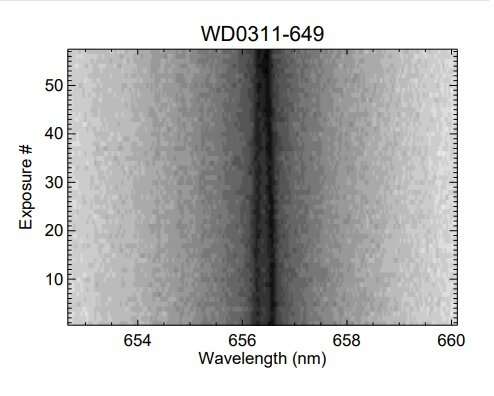February 25, 2020 report
Two new double-lined spectroscopic binary white dwarfs identified by astronomers

A team of U.S.-Canadian astronomers has conducted radial velocity observations of four binary white dwarf candidates. They report that two of them, designated WD 0311−649 and WD 1606+422, are apparently double-lined spectroscopic binary systems. The finding is detailed in a paper published February 14 on arXiv.org.
So far, the majority of binaries have been detected by Doppler shifts in their spectral lines, hence these systems are called spectroscopic binaries. Observations show that in some spectroscopic binaries, spectral lines from both stars are visible, and these lines are alternately double and single. These systems are known as double-lined spectroscopic binaries (SB2).
They are 17 SB2 white dwarf systems with well-measured mass and orbital parameters known to date. Finding new objects of this type could be crucial in order to advance our knowledge about double white dwarf and binaries population in general. Observations of SB2s may, for instance, help in studies of binary population synthesis models and the stability of mass transfer in their progenitor systems.
Now, a group of astronomers led by Mukremin Kilic of the University of Oklahoma, reports the finding of two new SB2 white dwarf systems as a result of spectroscopic observations of four over-luminous white dwarfs identified in 2017. The observations were conducted with the HIRES spectrometer on the Keck I telescope, the Gemini Multi-Object Spectrograph (GMOS) on the Gemini telescopes, and also the Goodman High-Throughput spectrograph at the SOAR telescope.
"We present radial velocity observations of four binary white dwarf candidates identified through their over-luminosity. We identify two new double-lined spectroscopic binary systems, WD 0311−649 and WD 1606+422, and constrain their orbital parameters," the researchers wrote in the paper.
According to the study, WD 0311−649 has orbital period of approximately 0.74 days. The binary consists of two white dwarf with masses of about 0.38 and 0.55 solar masses, which means a mass ratio at a level of 1.44. The less massive object has an effective temperature of 12,600 K, while its companion is about 300 K colder.
When it comes to WD 1606+422, the more massive component has a mass of about 0.6 solar masses and an effective temperature of 13,300 K. The companion has a mass of approximately 0.44 solar masses and an effective temperature of 11,500 K. The system has an orbital period of around 0.84 days.
The astronomers also provided some information about the two other systems investigated in the study, namely WD 1447−190 and WD 1418−088. The system WD 1447−190 was found to be a single-lined binary with a period of approximately 1.79 days consisting of two white dwarf with masses of 0.41 and 0.33 solar masses. When it comes to WD 1418−088, a binary white dwarf (0.6 and 0.68 solar masses), the researchers did not find any significant velocity variations over timescales ranging from minutes to decades.
In concluding remarks, the authors of the paper encourage astronomers to conduct more searchers for SB2 systems among the over-luminous white dwarf population. This could help build a large enough sample of SB2 systems that will enable the scientific community to compare against and constrain the population synthesis models for double white dwarfs.
More information: Two new Double-lined Spectroscopic Binary White Dwarfs, arXiv:2002.06214 [astro-ph.SR] arxiv.org/abs/2002.06214
© 2020 Science X Network



















